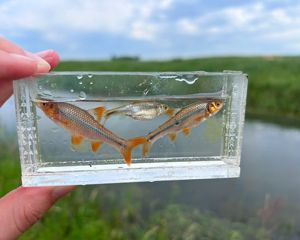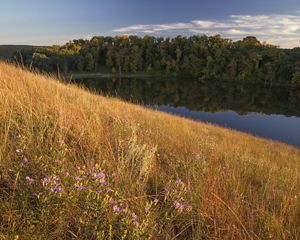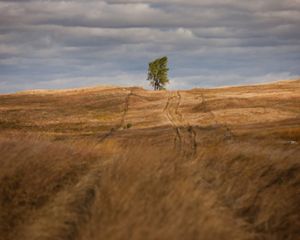Connected and Protected Grasslands
The Northern Tallgrass Prairie National Wildlife Refuge is a massive complex of lands protecting more than 15,000 acres.

Just 10 miles east of the South Dakota border, a nondescript dirt path cuts through an empty field. In every direction, a mix of switchgrass and big bluestem are turning the yellow-green of early spring. Smoke blooms on the horizon, announcing a prescribed burn on nearby Big Stone National Wildlife Refuge. A sharp-tailed grouse scuttles into the tall grass. Once a bustling farmstead, it’s the dawn of a new era for these acres: they’ve been protected by The Nature Conservancy as part of Northern Tallgrass Prairie National Wildlife Refuge (NTP NWR).
Established in 2000 by the U.S. Fish and Wildlife Service (USFWS), NTP NWR is a massive complex protecting more than 15,000 acres of prairie habitat between northwestern Iowa and western Minnesota. The refuge stretches across 85 counties with one central purpose: to slow the decline of North America’s native tallgrass prairie ecosystem, and the wildlife that rely on it, through protection and restoration.
Grasslands: most threatened, least protected
Scientists estimate that native prairie once blanketed as much as 25 million acres across Minnesota and Iowa. This connected swath of bluestem, switchgrass and other native plants provided habitat for bison, booming prairie chickens and rare butterflies like Dakota skipper. Now, less than 250,000 acres—a little more than 1%—remain.

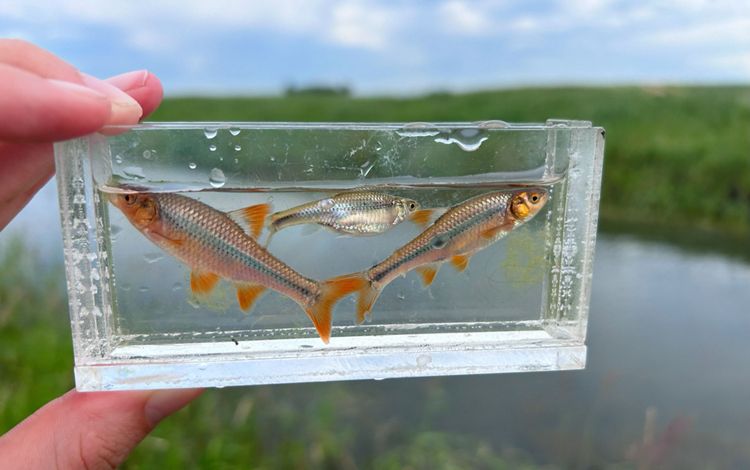


What’s behind this staggering loss? In Minnesota and Iowa, row crop agriculture is the main force driving grassland conversion. “For many landowners, it’s more lucrative to convert their acres to crops than maintain a native prairie,” said Chris McGrath, associate director of protection for TNC in Minnesota, North Dakota and South Dakota. But conversion comes at a cost: turning native prairie into cropland fragments the habitat of grassland plants and animals, many of which are already threatened. And when prairies are tilled for planting, the carbon once locked in their dense root systems is released into our atmosphere, contributing to warming temperatures. NTP NWR was formed to stave off this conversion, safeguarding the last stretches of remnant tallgrass prairie. Eventually, the U.S. Fish and Wildlife Service hopes the refuge will encompass 77,000 acres between Minnesota and northwestern Iowa, in a sprawling complex of protected and connected habitat.
Quote: Chris McGrath
For many landowners, it’s more lucrative to convert their acres to crops than maintain a native prairie.
All hands for the grasslands
Protecting this vast ecosystem takes deep collaboration between individuals, organizations and government agencies. When the refuge was first established in 2000, USFWS was the only entity protecting prairie in the region, using a small pot of federal funding. That meant a slow pace of protection, at least until 2013, when TNC added our boots to the ground. Using dollars from the voter-backed Outdoor Heritage Fund, TNC helps landowners place their grasslands under protection, then transfers management of the land to USFWS. Public funding has accelerated the pace and scale of protection in the northern tallgrass prairie. As of March 2025, OHF funds have helped to more than double the size of NTP NWR in Minnesota.
Voter-Supported Impact on Prairie Protection
The 9,406 acres added to NTP NWR with Outdoor Heritage Fund dollars include:
-
5,956
acres of untilled native prairie
-
719
acres of wetlands
-
31
miles of streamfront
-
2.5
miles of lakefront
NTP Specialist Becca Fitch conducts landowner outreach across southwestern Minnesota. She gets to know landowners’ histories, the ecological health of their property and the reasons behind their interest in protecting their land. Most “feel a heritage in the land and don’t want to see it turned into something else,” said Fitch. But they need financial support to make protection happen. Using Outdoor Heritage Fund dollars, TNC pays the landowner to place a conservation easement on their land and covers the cost of restoration: “a pretty good deal,” said Fitch.

Restoration and adaptation
TNC conducts initial restoration on newly protected properties before transferring them to USFWS for long-term management. Together with the landowner, specialists like Fitch determine which activities to start immediately, before the acres are transferred. Is the property former cropland that needs to be seeded with native grasses? Is there a structure, such as an old barn, requiring removal before restoration can begin? Is it overrun with invasives? Across the refuge, projects run the gamut from restoration—bringing properties as close as possible to pre-settlement condition—to adaptation, whereby landscapes are improved with a focus on climate resilience. Together, TNC and USFWS “try to strike a balance between restoring to past conditions and adapting to potential future conditions,” said Chris McGrath.
Stories of success
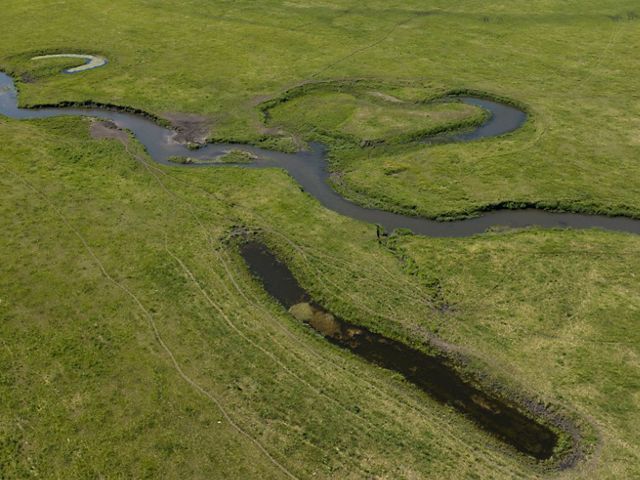
Oxbow Restoration
Rock County, MN
Topeka shiners are a tiny minnow that thrives in oxbows—ponds that form when a river or stream meanders. In Rock County, Minnesota, decades of farming have filled these freshwater tidepools with sediment, endangering the shiner’s habitat. Last year, TNC and USFWS restored four oxbows on a single property, resulting in a remarkable recovery for this endangered fish.
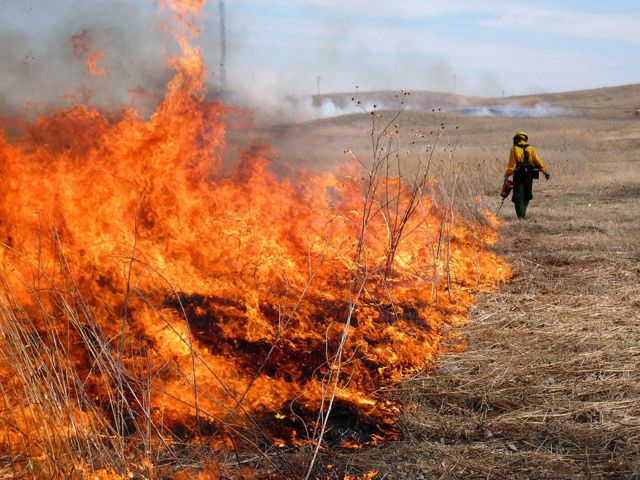
Prairie Fire
Big Stone County, MN
Our prairies evolved to thrive with regular, low-burning fires. At Big Stone National Wildlife Refuge, TNC partners with USFWS to conduct controlled burns across the refuge’s many acres of prairie. Burns occur throughout the spring, promoting diverse and resilient plant communities, controlling invasive species and removing thatch that is a barrier to insect and wildlife movement in the prairie.

Managed Grazing
Lincoln County, MN
Ranching is a way of life on the prairie, but good grass is hard to find in row-crop-dominated parts of the state. This means ranchers must spend money on hay and corn to feed their herds, which is more expensive and less nutritious for cattle. Each year, USFWS opens a select few units of NTP NWR for grazing leases, and ranchers bid to graze each unit for a period of 3-5 years. Grazing leases increase profits for ranchers, and because cows are fond of invasive grasses, native plants have a better chance to bloom.
Looking ahead
Unlike most national wildlife refuges, which are mostly contiguous stretches of land and protected for a singular purpose, NTP NWR consists of a patchwork of lands protected with different goals in mind. This method brings biodiversity to the refuge, allowing TNC and USFWS to protect many types of tallgrass prairie under one initiative. “It’s not a one-stop refuge,” said Becca Fitch, “and I think that’s really special.”
None of this protection would be possible without Minnesota’s voter-backed Outdoor Heritage Fund, created under the Clean Water, Land and Legacy Amendment. With a goal to protect 77,000 acres of prairie through NTP NWR, continued voter engagement in support of Legacy Amendment is crucial to TNC’s and USFWS’s joint efforts to safeguard the last pockets of these iconic grasslands.
